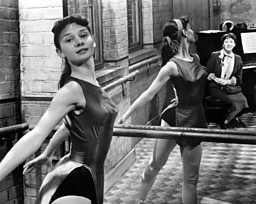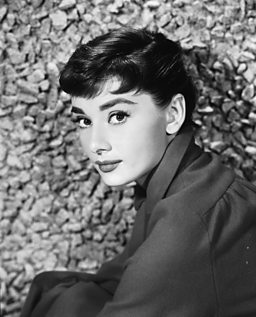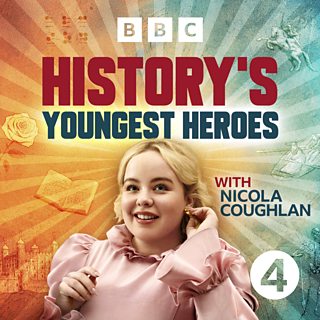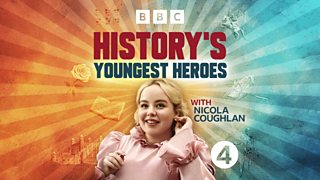Audrey Hepburn’s secret role in WWII
In the ����ý Radio 4 podcast History’s Youngest Heroes, Nicola Coughlan shines a light on extraordinary stories of rebellion, risk, and the radical power of youth, looking at young people throughout history who have changed the world.
One episode focuses on Audrey Hepburn, who became a film and fashion icon in the 1950s and 1960s: nominated for five Oscars and winning one. Yet as a teenager during the Second World War she played a very different role – staging secret ballet performances to raise money for the Dutch resistance to Nazi occupation.
What was Audrey Hepburn’s family background?
She was born in Brussels in 1929 to a Dutch baroness, Ella van Heemstra, and a British-Austrian businessman, Joseph Hepburn-Ruston. In London, her parents were drawn to Oswald Mosley, leader of the violently antisemitic British Union of Fascists. Ella wrote an article for the BUF’s magazine on what she saw as the glories of Nazi Germany. Joseph walked out on the family when Audrey was six years old. He would later be arrested as “an associate of foreign fascists” and spend the war in British prisons.
When Audrey turned 15, she was ordered to join the Nazi Kulturkammer, their artists’ union, or give up publicly performing dance. She chose to give up performing.
What happened when war broke out?
Ella pulled Audrey out of her British boarding school. They moved to a family estate in the Netherlands, with Audrey going by a more Dutch-sounding name, Adriaantje van Heemstra. Audrey enrolled in a dance school. Ella still admired Adolf Hitler and believed he would never invade “her” country. He did, though, in May 1940.
Audrey’s uncle, Count Otto van Limburg Stirum, took a principled stand against the Nazis. In 1942, a resistance group attempted to blow up a German train near Rotterdam. Though Count van Limburg Stirum was not involved, he was arrested because he was a prominent anti-Nazi figure. Nazi agents drove him and four others into the forest, shot them, and dumped their bodies in unmarked graves. Audrey loved her uncle as a surrogate father, and was devastated by his murder.
Did Audrey experience hardship under the occupation?
Yes. Though her family was privileged, the Nazis diverted food and resources away from the Netherlands, and the Heemstra family went hungry. When Audrey turned 15, she was ordered to join the Nazi Kulturkammer, their artists’ union, or give up publicly performing dance. She chose to give up performing.
How did she get involved with the resistance?
In spring 1944, she volunteered as an assistant to a doctor – Henrik Visser ’t Hooft –who was a member of the resistance. Though Audrey’s mother Ella was widely seen as a collaborator with the Nazis, Visser ’t Hooft desperately needed help to support thousands of people who were in hiding from the Nazis. He trusted Audrey enough to bring her in.
What were Audrey’s performances like?
She had to dance in a safe house with closed blinds and only a candle for light, so they would not be discovered. A piano played very softly while she performed – but there could be no applause. At the end of the show, money was collected for the resistance.

What happened when the Allies invaded the Netherlands?
On 17 September 1944, Audrey was at church when the hymn was interrupted by the whirr of engines. Operation Market Garden had started – and when she ran outside and looked up, thousands of Allied troops were floating down on parachutes. Unfortunately, two heavily armoured Nazi divisions were regrouping in the area. Nazi tanks rolled in front of the Heemstras’ house. Audrey and her family hid in the cellar while the battle raged for nine days. When they emerged, it was to the news that the Nazis had won. Audrey heard screams from a building where the Nazis were carrying out reprisals: torturing and killing members of the Dutch resistance.
Did this frighten Audrey off from her resistance work?
Quite the opposite. When Allied airmen heading for Germany had to make an emergency landing in the Netherlands, Visser ’t Hooft sent her to the forest to meet a British paratrooper with code words and a secret message hidden in her sock. Audrey made the meeting, but on the way out of the forest she saw Dutch police approaching. She bent down to pick wildflowers, then flirtatiously presented them to the police. They were charmed and didn’t interrogate her further. After this, she often carried messages for the resistance.
What happened to Audrey during the famine over the winter of 1944-45?
By February 1945, it was reported that 500 Dutch people were starving to death every week. Like so many others, Audrey and her family were desperately short of food. Audrey became severely ill with anaemia, jaundice and oedema.
When were the Netherlands liberated?
With ferocious fighting again raging outside their front door, Audrey and her family hid in the cellar again for three weeks. Finally, on 16 April 1945, it went quiet. Audrey smelled tobacco, which was impossible to get during the war in the Netherlands. She climbed the stairs from the cellar and opened the door to see five Canadian soldiers smoking cigarettes and pointing machine guns at her. Immediately, she started to speak to them in English. One yelled: “Not only have we liberated a town – we’ve liberated an English girl!”
What happened to Audrey after the war?
Audrey later told her son Luca Dotti that she never forgave her mother for having fascist sympathies. When the war was over, she won a scholarship to Ballet Rambert in London. Though she was talented, her constitution was permanently damaged by malnutrition, and she did not have the stamina to become a ballerina. Instead, she turned to acting, with small roles in West End theatre and films such as The Lavender Hill Mob.
In 1953, she won her first Hollywood starring role in Roman Holiday. The film was a massive critical and commercial success. Audrey Hepburn won the Academy Award for Best Actress. Yet through all her stardom she never gave up on her charitable work, notably as a goodwill ambassador for UNICEF. She died in 1993.






